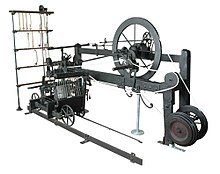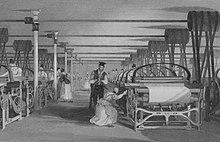ব্যবহারকারী:Sony0006/শিল্প বিপ্লবের সময় পোশাক উৎপাদন

ব্রিটেনের শিল্প বিপ্লবের সময় টেক্সটাইল উত্পাদন দিক দিয়ে দক্ষিণ ল্যাঙ্কাশায়ার এবং পেনিনী উভয় শহরগুলিতে কেন্দ্রীভূত ছিল। জার্মানিতে এটি ওয়াপারের ভ্যালি, রুহর অঞ্চলের এবং ঊর্ধ্ব সিলিয়াসায় বিস্তৃত ছিল, মার্কিন যুক্তরাষ্ট্রে যখন নিউ ইংল্যান্ডে মধ্যে ছিল। শিল্প বিপ্লবের চারটি মূল চালিকাশক্তি টেক্সটাইল উৎপাদন, লোহা প্রতিষ্ঠা, বাষ্প শক্তি এবং সস্তা শ্রম।
আঠারো শতাব্দীর আগে, বস্ত্র উৎপাদন পৃথক কর্মীদের দ্বারা পরিচালিত হত, যেখানে তারা বসবাস করত সে স্থানগুলিতে এবং পণ্য সারা দেশের পরিবহন করা হত অথবা পণ্য গুলো নদীবন্দর দিয়ে বিভিন দেশের সরবরাহ করা হত এবং সীমার সূচক রেখা খালগুলো দিয়ে যেগুলো আাঠার শতকের প্রথম দিকে নির্মিত হয়েছিল।। আঠারো শতকের মাঝামাঝি সময়ে, কারিগররা আরো উৎপাদনশীল হয়ে উঠার উপায় উদ্ভাবন করেছিল। তুলা দিয়ে সিল্ক, উল, এবং পুরো খসখসে সুতি কাপড় বোনা শিক্ষে ছিল যা বস্ত্রশিল্পে সবচেয়ে গুরুত্বপূর্ণ হয়ে ওঠে।
শিল্প বিপ্লবের উপাদানসমূহ [সম্পাদনা]

শিল্প বিপ্লবের প্রারম্ভে ১৮ শতকের দ্বিতীয়ার্ধে একটি ছোট্ট নতুন আবিষ্কারের সাথে ঘনিষ্ঠ সম্পর্ক রয়েছে:
তুলা উৎপাদন[সম্পাদনা]
তুলা বিশ্বের সবচেয়ে গুরুত্বপূর্ণ প্রাকৃতিক ফাইবার। ২০০৫ সালে ৫০ টিরও বেশি দেশে চাষাবাদে ৩৫ মিলিয়ন হেক্টর থেকে বিশ্বব্যাপী ২৫ মিলিয়ন টন ফলন হয়।
এর পাঁচটি ধাপ রয়েছে
১. চাষাবাদ এবং ফলন
শিল্প এবং আবিষ্কার[সম্পাদনা]
Before the 1760s, textile production was a cottage industry using mainly flax and wool. A typical weaving family would own one hand loom, which would be operated by the man with help of a boy; the wife, girls and other women could make sufficient yarn for that loom.


Robert's power loom[সম্পাদনা]

Robert's self acting mule[সম্পাদনা]

Also in 1830, Richard Roberts patented the first self-acting mule. The Stalybridge mule spinners strike was in 1824, this stimulated research into the problem of applying power to the winding stroke of the mule.[১][২] The draw while spinning had been assisted by power, but the push of the wind had been done manually by the spinner, the mule could be operated by semiskilled <g class="gr_ gr_9 gr-alert gr_spell gr_inline_cards gr_run_anim ContextualSpelling multiReplace" id="9" data-gr-id="9">labour</g>. Before 1830, the spinner would operate a partially powered mule with a maximum of 400 spindles after, self-acting mules with up to 1,300 spindles could be built.[৩]
Working practices[সম্পাদনা]
The early textile factories employed a large share of children, but the share declined over time. In England and Scotland in 1788, two-thirds of the workers in 143 water-powered cotton mills were described as children. Sir Robert Peel, a mill owner turned reformer, promoted the 1802 Health and Morals of Apprentices Act, which was intended to prevent pauper children from working more than 12 hours a day in mills. Children had started in the mills at around the age of four, working as mule scavengers under the working machinery until they were eight, they progressed to working as little piecers which they did until they were 15. During this time they worked 14 to 16 hours a day, being beaten if they fell asleep.[৪] The children were sent to the mills of Derbyshire, Yorkshire and Lancashire from the workhouses in London and other towns in the south of England. A well-documented example was that of Litton Mill. Further legislation followed. By 1835, the share of the workforce under 18 years of age in cotton mills in England and Scotland had fallen to 43%. About half of workers in Manchester and Stockport cotton factories surveyed in 1818 and 1819 had begun work at under ten years of age.[৫] Most of the adult workers in cotton factories in mid-19th-century Britain were workers who had begun work as child labourers. The growth of this experienced adult factory workforce helps to account for the shift away from child labour in textile factories.
.
- ↑ Roberts, Richard (DNB00) – উইকিসংকলন-এর মাধ্যমে।
- ↑ Hills 1993, পৃ. 118
- ↑ Williams ও Farnie 1992।
- ↑ Rowland, David (১৮৩২), Children of the Revolution, Cotton Times, সংগ্রহের তারিখ ২০১০-০২-০৯
- ↑ Galbi, Douglas (১৯৯৭)। "Child Labor and the Division of Labor in the Early English Cotton Mills"। Journal of Population Economics। 10 (4): 357–75।
- Copeland, Melvin Thomas. The cotton manufacturing industry of the United States (Harvard University Press, 1912) online
- Cameron, Edward H. Samuel Slater, Father of American Manufactures (1960) scholarly biography
- Conrad, Jr., James L. "'Drive That Branch': Samuel Slater, the Power Loom, and the Writing of America's Textile History," Technology and Culture, Vol. 36, No. 1 (January 1995), pp. 1–28 in JSTOR
- Griffin, Emma, A Short History of the British Industrial Revolution (Palgrave, 2010), pp. 86–104
- Griffiths, T., Hunt, P.A., and O'Brien, P. K. "Inventive activity in the British textile industry", Journal of Economic History, 52 (1992), pp. 881–906.
- Griffiths, Trevor; Hunt, Philip; O'Brien, Patrick. "Scottish, Irish, and imperial connections: Parliament, the three kingdoms, and the mechanization of cotton spinning in eighteenth-century Britain," Economic History Review, Aug 2008, Vol. 61 Issue 3, pp 625–650
- Power from Steam: A History of the Stationary Steam Engine, ১৯৯৩
- A & G Murray and the Cotton Mills of Ancoats, ২০০৭
- Ray, Indrajit (2011). Bengal Industries and the British Industrial Revolution (1757-1857), Routledge, আইএসবিএন ১১৩৬৮২৫৫২৫.
- Tucker, Barbara M. "The Merchant, the Manufacturer, and the Factory Manager: The Case of Samuel Slater," Business History Review, Vol. 55, No. 3 (Autumn, 1981), pp. 297–313 in JSTOR
- Tucker, Barbara M. Samuel Slater and the Origins of the American Textile Industry, 1790–1860 (1984)
- Cotton Mills of Greater Manchester, ১৯৯২
